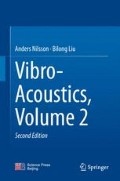Abstract
Maximum permissible noise and vibration levels are often required for most types of machinery, vehicles, and buildings.
Access this chapter
Tax calculation will be finalised at checkout
Purchases are for personal use only
Author information
Authors and Affiliations
Corresponding author
Problems
Problems
16.1
Derive Eq. (16.1).
16.2
An acoustic source is located in a room. Determine the modal energy of the acoustic field in the room. The equivalent absorption area in the room is A. Assume that the field is induced by a number of sources scattered in the room. The power spectral density of the total volume velocity of the sources is \(G_Q \) and is constant.
16.3
Derive the sound pressure level difference between the rooms 1 and 3 shown in Fig. 16.6 by using the appropriate coupling loss factors.
16.4
Derive the coupling loss factor \(\eta _{13} \) between the rooms 1 and 3 shown in Fig. 16.6. The coupling loss factor \(\eta _{13} \) defines the nonresonant transmission through a panel having the sound transmission coefficient \(\tau \).
16.5
Derive the modal density in a narrow cavity, height d, having the dimensions \(L_x\) and \(L_y\) for \(f < c/(2d)\). Compare Eq. (16.60).
16.6
Determine the coupling loss factor between two plates. Consider only flexural waves. Only rotation at the junction. Compare Eq. (16.60).
16.7
Determine the coupling loss factor between the two rods shown in Fig. 16.12. Consider only longitudinal waves in the rods. Compare Eq. (16.78).
16.8
Derive the expression (16.74).
Rights and permissions
Copyright information
© 2016 Science Press, Beijing and Springer-Verlag Berlin Heidelberg
About this chapter
Cite this chapter
Nilsson, A., Liu, B. (2016). Transmission of Sound in Built-Up Structures. In: Vibro-Acoustics, Volume 2. Springer, Berlin, Heidelberg. https://doi.org/10.1007/978-3-662-47934-6_16
Download citation
DOI: https://doi.org/10.1007/978-3-662-47934-6_16
Published:
Publisher Name: Springer, Berlin, Heidelberg
Print ISBN: 978-3-662-47933-9
Online ISBN: 978-3-662-47934-6
eBook Packages: Physics and AstronomyPhysics and Astronomy (R0)

